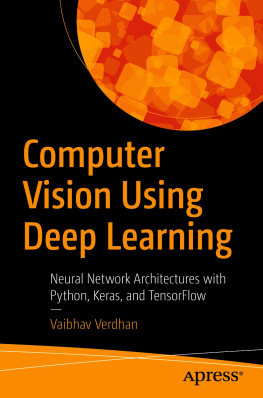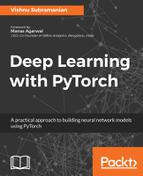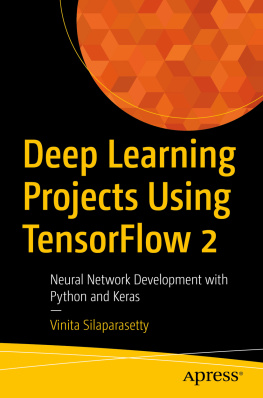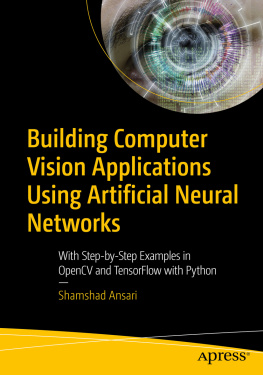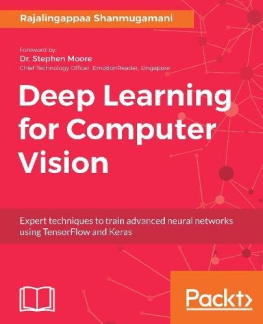Vaibhav Verdhan - Computer Vision Using Deep Learning: Neural Network Architectures with Python and Keras
Here you can read online Vaibhav Verdhan - Computer Vision Using Deep Learning: Neural Network Architectures with Python and Keras full text of the book (entire story) in english for free. Download pdf and epub, get meaning, cover and reviews about this ebook. year: 2021, publisher: Apress, genre: Children. Description of the work, (preface) as well as reviews are available. Best literature library LitArk.com created for fans of good reading and offers a wide selection of genres:
Romance novel
Science fiction
Adventure
Detective
Science
History
Home and family
Prose
Art
Politics
Computer
Non-fiction
Religion
Business
Children
Humor
Choose a favorite category and find really read worthwhile books. Enjoy immersion in the world of imagination, feel the emotions of the characters or learn something new for yourself, make an fascinating discovery.
- Book:Computer Vision Using Deep Learning: Neural Network Architectures with Python and Keras
- Author:
- Publisher:Apress
- Genre:
- Year:2021
- Rating:5 / 5
- Favourites:Add to favourites
- Your mark:
- 100
- 1
- 2
- 3
- 4
- 5
Computer Vision Using Deep Learning: Neural Network Architectures with Python and Keras: summary, description and annotation
We offer to read an annotation, description, summary or preface (depends on what the author of the book "Computer Vision Using Deep Learning: Neural Network Architectures with Python and Keras" wrote himself). If you haven't found the necessary information about the book — write in the comments, we will try to find it.
Vaibhav Verdhan: author's other books
Who wrote Computer Vision Using Deep Learning: Neural Network Architectures with Python and Keras? Find out the surname, the name of the author of the book and a list of all author's works by series.
Computer Vision Using Deep Learning: Neural Network Architectures with Python and Keras — read online for free the complete book (whole text) full work
Below is the text of the book, divided by pages. System saving the place of the last page read, allows you to conveniently read the book "Computer Vision Using Deep Learning: Neural Network Architectures with Python and Keras" online for free, without having to search again every time where you left off. Put a bookmark, and you can go to the page where you finished reading at any time.
Font size:
Interval:
Bookmark:
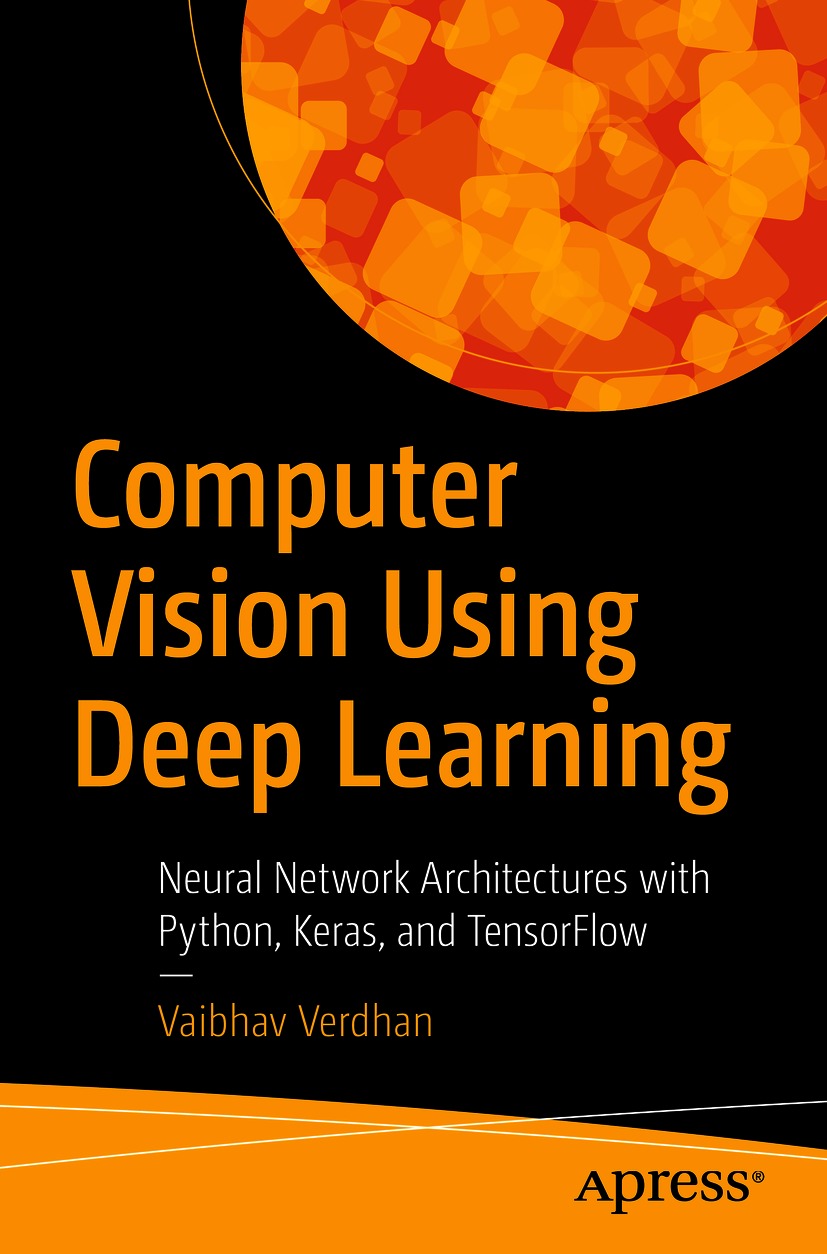

Any source code or other supplementary material referenced by the author in this book is available to readers on GitHub via the books product page, located at www.apress.com/978-1-4842-6615-1 . For more detailed information, please visit http://www.apress.com/source-code .
To Yashi, Pakhi and Rudra
Computer Vision, not too long ago the exclusive purview of science fiction, is quickly becoming commonplace across industries, if not in society at large. The progress in the field to emulate human vision, that most prized of human senses, is nothing but astonishing. It was only 1957 when Russell Kirsch scanned the worlds first photograph, a black and white image of his boy, when in 2010, it incorporated face recognition in its social media platform.
The capabilities of Deep Learning vision systems to interpret and extract information from images permeates all aspects of society. Only the most skeptical among us doubt a not too distant future with self-driving cars outnumbering those driven by their human counterparts or computer-aided diagnosis (CADx) of medical images becoming an ordinary service supplied by medical providers. Computer vision applications already control access to our mobile devices and can outperform human inspectors in the tedious but critical task of inspecting for defects in all types of manufacturing processes. That is how I met Vaibhav, or V, as he is known to his friends and colleagues. Collaborating on methods to improve existing computer vision systems to ensure defect-free products critical for human vision. Not lost is an appreciation of the circular history. We teach computers how to see; they help manufacture products vital to improve and care for human vision.
In this book, V takes a practical and convenient approach to the subject. The abundant use of case studies is facilitated by ready-to-use Python code and links to datasets and other tools. The practitioners learning experience is enhanced by access to the resources needed to work in a step-by-step fashion through each case study. The book organizes the subject into three parts. In chapters , we review the complete model development process, starting with a correctly defined business problem and systematically advancing until the model is deployed and maintain in a production environment.
We are now just starting to see the dramatic increase in complexity and impact of tasks performed by computer systems that match and often exceed what until recently, would be considered exclusively human vision capabilities. Those aspiring to make this technology their ally, grow more adept at incorporating vision systems into their practice, and become a more skillful practitioner will greatly gain from the tools, techniques, and methods presented in this book.
David O. Ramos
Jacksonville, FL
16 December 2020
Innovation distinguishes between a leader and a follower.
Steve Jobs
How good is your driving? Will you drive better than an autonomous driving system? Or do you think an algorithm will perform better than a specialist in classifying medical images? It can be a tricky question. But artificial intelligence has outperformed doctors in detecting lung cancer and breast cancer by analyzing images! Ouch!
Nature has been very kind to grant us powers of sight, taste, smell, touch, and hearing. Out of these senses, the power of sight allows us to appreciate the beauty of the world, enjoy the colors, recognize the faces of our family and loved ones, and above all relish this beautiful world and life. With time, humans amplified the power of the brain and made path-breaking inventions and discoveries. The wheel or airplane, printing press or clock, light bulb or personal computers innovations have changed the way we live, work, travel, decide, and progress. These innovations make life simpler, easier, and far enjoyable and safe.
Data science and Deep Learning are allowing us to further enhance the innovative buckets. Using Deep Learning, we are able to replicate the power of vision given by nature. The computers are being trained to perform the same tasks done by a human being. It can be detection of colors or shape or size, classifying between a cat or a dog or a horse, or driving on a road the use cases are many. The solutions are applicable for all the sectors like retail, manufacturing, BFSI, agriculture, security, transport, pharmaceuticals, and so on.
This book is an attempt to explain the concepts of Deep Learning and Neural Network for computer vision problems. We are examining convolutional Neural Networks in detail, and their various components and attributes. We are exploring various Neural Network architectures like LeNet, AlexNet, VGG, R-CNN, Fast R-CNN, Faster R-CNN, SSD, YOLO, ResNet, Inception, DeepFace, and FaceNet in detail. We are also developing pragmatic solutions to tackle use cases of binary image classification, multiclass image classification, object detection, face recognition, and video analytics. We will use Python and Keras for the solutions. All the codes and datasets are checked into the GitHub repo for quick access. In the final chapter, we are studying all the steps in a Deep Learning project right from defining the business problem to deployment. We are also dealing with major errors and issues faced while developing the solutions. Throughout the book, we are providing tips and tricks for training better algorithms, reducing the training time, monitoring the results, and improving the solution. We are also sharing prominent research papers and datasets which you should use to gain further knowledge.
Font size:
Interval:
Bookmark:
Similar books «Computer Vision Using Deep Learning: Neural Network Architectures with Python and Keras»
Look at similar books to Computer Vision Using Deep Learning: Neural Network Architectures with Python and Keras. We have selected literature similar in name and meaning in the hope of providing readers with more options to find new, interesting, not yet read works.
Discussion, reviews of the book Computer Vision Using Deep Learning: Neural Network Architectures with Python and Keras and just readers' own opinions. Leave your comments, write what you think about the work, its meaning or the main characters. Specify what exactly you liked and what you didn't like, and why you think so.

